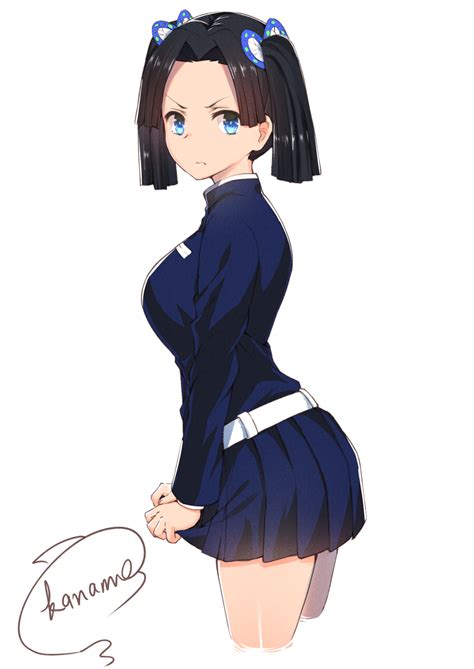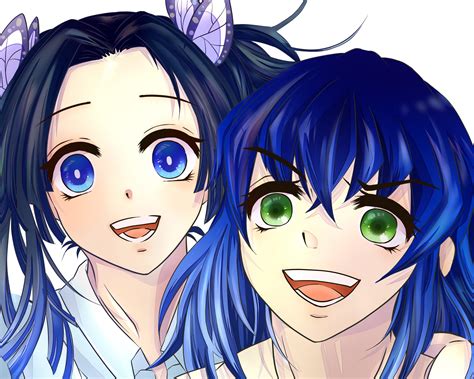Aoi Demon Slayer Rule 34: Exploring the Fan Art Phenomenon

Disclaimer: This article discusses a mature topic related to fan-generated content and includes references to adult themes. Reader discretion is advised.
In the vast landscape of anime fandom, few series have captured the imagination of fans quite like Demon Slayer: Kimetsu no Yaiba. With its captivating storyline, stunning animation, and memorable characters, the series has inspired a plethora of fan-created content, ranging from fan fiction to cosplay. However, one aspect of this fandom has sparked both fascination and controversy: the emergence of Rule 34-inspired fan art, particularly featuring the character Aoi.
Rule 34, an internet adage, states that "if it exists, there is porn of it." This concept has become a driving force behind the creation of explicit fan art, as fans explore the boundaries of their favorite characters and worlds. In the case of *Demon Slayer*, Aoi, a skilled and alluring demon slayer, has become a focal point for this phenomenon.
The Allure of Aoi: A Character Analysis
Who is Aoi?

Aoi Kanzaki, a member of the Demon Slayer Corps, is a character known for her exceptional swordsmanship, strategic mind, and captivating presence. Her unique abilities, including her Serpent Breathing technique, have made her a fan favorite. Aoi’s design, featuring a distinctive snake-themed outfit and a confident demeanor, has further contributed to her popularity.
Aoi's character embodies a blend of strength, intelligence, and sensuality, making her an ideal subject for fan art exploration. Her popularity has transcended the boundaries of the anime, sparking a dedicated fanbase that seeks to reinterpret and reimagine her in various contexts.
The Fan Art Phenomenon

The Rule 34 fan art movement surrounding Aoi can be attributed to several factors:
- Character Appeal: Aoi’s captivating personality and design have made her a natural choice for fan artists seeking to explore explicit themes.
- Fandom Engagement: The Demon Slayer fanbase is known for its creativity and passion, driving the production of diverse fan-generated content.
- Internet Culture: The prevalence of Rule 34 and its associated communities has facilitated the sharing and creation of explicit fan art.
Pros of Rule 34 Fan Art
- Enables fans to express their creativity and explore alternative interpretations of characters
- Fosters a sense of community among fans who share similar interests
- Provides a platform for artists to showcase their skills and gain recognition
Cons of Rule 34 Fan Art
- Raises concerns about the objectification and sexualization of characters
- May perpetuate harmful stereotypes or reinforce problematic power dynamics
- Can be seen as a distraction from the original work's themes and messages
The Creative Process: Behind the Scenes
Creating Rule 34 Fan Art: A Typical Workflow
- Inspiration: Artists draw inspiration from the source material, fan communities, or personal fantasies.
- Concept Development: Ideas are refined, and characters are reimagined in explicit contexts.
- Sketching and Line Art: Initial sketches are created, followed by detailed line art.
- Coloring and Shading: Digital tools are used to add color, texture, and depth to the artwork.
- Sharing and Feedback: Completed pieces are shared online, often receiving feedback and engagement from the fan community.
The Impact on Fandom and Beyond
The Rule 34 fan art phenomenon has significant implications for the Demon Slayer fandom and beyond. It raises questions about the boundaries of fan creativity, the role of explicit content in fan communities, and the relationship between fans and the original work."The internet has democratized creativity, allowing fans to reinterpret and reimagine their favorite characters in ways that both celebrate and challenge the source material." – Dr. Emily Wong, Media Studies Scholar
A Brief History of Fan Art and Rule 34
The concept of Rule 34 can be traced back to the early days of the internet, where fans began creating explicit content featuring their favorite characters. Over time, this phenomenon has evolved, with fan artists pushing the boundaries of what is possible and acceptable. The rise of social media and online communities has further facilitated the sharing and creation of Rule 34 fan art, making it an integral part of modern fandom culture.
Navigating the Complexities
As the Rule 34 fan art movement continues to evolve, it is essential to acknowledge the complexities and nuances surrounding this phenomenon. While it provides a platform for creative expression, it also raises important questions about consent, representation, and the impact on the original work.Future Directions
The future of Rule 34 fan art will likely involve ongoing debates about the boundaries of fan creativity, the role of online communities in shaping fan culture, and the need for respectful and inclusive representations of characters. As the *Demon Slayer* fandom and others continue to grow, it is crucial to foster a culture that values diversity, consent, and the original creators' visions.
Is Rule 34 fan art legal?
+The legality of Rule 34 fan art is a complex issue, as it often involves copyright infringement and potential violations of the original creators' rights. While some fan artists argue that their work falls under fair use, others acknowledge the need for clearer guidelines and respect for the original work.
How does Rule 34 fan art impact the original work?
+Rule 34 fan art can have both positive and negative impacts on the original work. While it can increase engagement and interest in the series, it may also distract from the original themes and messages. Furthermore, explicit fan art can perpetuate harmful stereotypes or reinforce problematic power dynamics, potentially damaging the reputation of the original work.
What are some best practices for creating Rule 34 fan art?
+Best practices for creating Rule 34 fan art include respecting the original creators' rights, avoiding harmful stereotypes, and prioritizing consent and inclusivity. Artists should also be mindful of the potential impact of their work on the fandom and the original series, striving to create content that is both creative and respectful.
Can Rule 34 fan art be considered a form of artistic expression?
+Yes, Rule 34 fan art can be considered a form of artistic expression, as it allows fans to explore their creativity and reinterpret characters in new and innovative ways. However, it is essential to recognize the complexities and nuances surrounding this phenomenon, acknowledging the potential risks and challenges associated with explicit fan art.
How can fans engage with Rule 34 content responsibly?
+Fans can engage with Rule 34 content responsibly by being mindful of the potential impact of their actions, respecting the original creators' rights, and prioritizing consent and inclusivity. This includes avoiding the sharing of explicit content without permission, being cautious when interacting with fan artists, and supporting the creation of respectful and inclusive fan art.
In conclusion, the Rule 34 fan art phenomenon surrounding Aoi and Demon Slayer highlights the complex and multifaceted nature of fan creativity. As fans continue to explore the boundaries of their favorite characters and worlds, it is essential to navigate these complexities with nuance, respect, and an appreciation for the original work. By acknowledging the risks and challenges associated with explicit fan art, we can foster a more inclusive and responsible fan culture that celebrates creativity while prioritizing consent and the original creators’ visions.